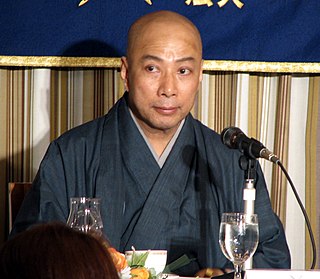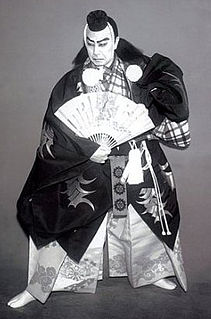
Matsumoto Hakuō II is a Japanese kabuki actor, one of the most popular tachiyaku currently performing.

Ichikawa Danjūrō IX was one of the most successful and famous Kabuki actors of the Meiji period (1868–1912).

Ichikawa Ebizō is a stage name taken on by a series of Kabuki actors of the Ichikawa family. Most of these were blood relatives, though some were adopted into the family. It is a famous and important name, and receiving it is an honor.

Ichikawa Danjūrō XII was a Japanese actor. He is the twelfth kabuki actor to hold the illustrious name Ichikawa Danjūrō.

Bandō Shūka I, also known as Bandō Tamasaburō I, was a Japanese Kabuki actor, and the first in the lineage to hold each of the stage-names Shūka and Tamasaburō.

Matsumoto Hakuō I, born Junjirō Fujima, was a Japanese Kabuki actor, regarded as the leading tachiyaku of the postwar decades; he also performed in a number of non-kabuki venues, including Western theatre and films. Taking the name Hakuō upon retirement, he was known as Matsumoto Kōshirō VIII for much of his career.

Ichikawa Danjūrō I was an early kabuki actor in Japan. He remains today one of the most famous of all kabuki actors and is considered one of the most influential. His many influences include the pioneering of the aragoto style of acting which came to be largely associated with Edo kabuki and with Danjūrō and his successors in the Ichikawa Danjūrō line.

Ichikawa Shinnosuke is a stage name taken on by a series of Kabuki actors of the Ichikawa family. Most of these were blood relatives, though some were adopted into the family.

Ichikawa Danjūrō VII was a Japanese kabuki actor who specialized in male hero (tachiyaku) roles, said to be the greatest of the 19th century. He was responsible for the establishment of the Kabuki Jūhachiban, a collection of the eighteen greatest plays in the repertoire.

Ichikawa Danjūrō VIII was a Japanese kabuki actor of the prestigious Ichikawa Danjūrō line. He was a tachiyaku actor in the aragoto style, like all members of the lineage, but particularly specialized in the roles of young lovers, for which he was extremely popular.

Ichikawa Ebizo XI is a Japanese Kabuki, film, television actor and stage producer. He is the eldest son and successor of the celebrated Ichikawa Danjuro XII. He is the eleventh holder of the Ebizo’s name.

Onoe Kikugorō V was a Japanese Kabuki actor, one of the three most famous and celebrated of the Meiji period, along with Ichikawa Danjūrō IX and Ichikawa Sadanji I. Unlike most kabuki actors, who specialize in a particular type of role, Kikugorō, as a kaneru yakusha, played both tachiyaku and onnagata (women) roles and was best known for his roles in plays by Kawatake Mokuami. Kikugorō was also known as one of the chief actors in the "modern" subgenre of kabuki plays known as zangirimono, featuring Western-style clothes and hairstyle.

Ichikawa Danjūrō II was a Japanese kabuki performer in the lineage of a celebrated family of actors from the Edo region. Ichikawa Danjūrō is a stage name.
Ichikawa Raizō is a stage name used by Kabuki actors, beginning with a student of Ichikawa Danjūrō II; the use of the name 'Ichikawa' therefore emphasizes this connection.
Matsumoto Koshirō X is a Japanese actor and kabuki actor. His yagō is the Kōraiya. His mon is the Mitsu Ichō, and his kaemon is Yotsu Hana-bishi.



















